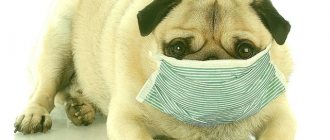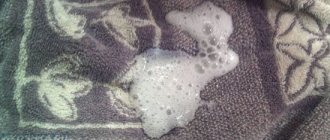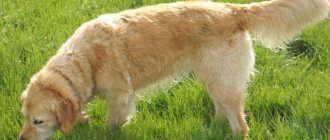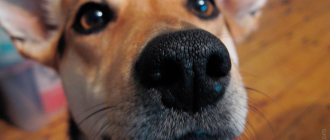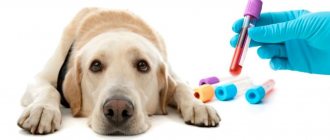Published: 1 year ago ⭐️⭐️⭐️⭐️⭐️
If a dog owner notices that their dog is vomiting yellow foam, they begin to worry about how dangerous such a symptom could be.
Vomiting is not an independent disease.
This is a manifestation of digestive disorders caused by viral or infectious diseases, functional disorders in the gastrointestinal tract, or diseases that develop in the body when infected with helminths. It is better not to treat vomiting separately. Eliminating symptoms will not cure, but will only complicate diagnosis.
Causes of foamy vomiting
We need to figure out why the dog is vomiting yellow foam. The formation of foam is a natural process that occurs in the stomach of an animal. When the stomach is empty, the mucus that envelops it protects against the process of self-digestion. It also contains a small amount of digestive juice. High molecular weight polysaccharides and proteins, interacting with the oxygen that the dog swallows, form foam. It is colored yellowish by the remains of gastric juice. Therefore, if you leave cleaning up a puddle of vomit for later, you can see that over time the foam will simply settle and yellow water with mucus will remain.
Take the Attention Test! Find 10 differences! (click right here!)
Find the answer Are you bothered by some problem or question? Enter “Breed” or “Name of the problem” into the form, press Enter and you will find out everything about the issue that interests you.
Your pet may feel nauseous when he wants to eat or when a foreign object enters the stomach. The dogs begin to vomit as they greedily eat the grass. This is an instinct that occurs when a feeling of heaviness or bloating occurs. This is how animals make it easier to cleanse the body.
Why does vomit turn yellow?
The walls of the stomach are covered with mucus, which protects against the aggressive effects of gastric juice. The air swallowed by the dog penetrates inside and enters into a chemical reaction with the mucus. The result is a clear or pale yellow foam. Its light color is given by gastric juice, and the more intense shade of yellow is due to mixing with bile. It is produced by hepatocytes - liver cells. Normally, this fluid accumulates in the gallbladder and small intestine, but under the influence of certain physiological and pathological reasons it penetrates into the stomach.
When treatment is not needed
- If the dog is hungry. When your dog vomits before eating every now and then in the morning, it may simply be getting rid of excess digestive juices. Prolonged hunger can cause nausea and vomiting, but if the pet’s health does not worsen, and these episodes happen quite rarely, then there is no reason to worry. Correcting your diet and diet will help you cope with the problem.
- When a pet swallows a foreign object. If the day before the dog accidentally swallowed a small pebble, fragment of a toy or bone, this will cause a morning attack of vomiting. More often than not, owners then find these foreign objects in a puddle on the floor.
It should be remembered that after the spontaneous release of inedible objects, it is necessary to monitor the pet’s condition throughout the day. He could have swallowed several fragments of bone or a toy, which could subsequently block the intestines.
Carrying out an ultrasound
Ultrasound examination is an absolutely accurate, painless and safe method of diagnosis. The veterinarian will evaluate the condition of the gallbladder, liver, fullness of the stomach and intestines, the presence of foreign bodies or tumors. No special preparation is required, the only thing is that the owner must stop giving the animal foods that can cause intestinal flatulence (legumes, baked goods, fatty foods) one day before and give several tablets of activated carbon, calculating the dosage based on body weight. If the dog is vomiting at the time of the examination, but also suffers from constipation, then it is necessary to give an enema. The procedure should take place in a calm environment, the animal should not be nervous. The pet is placed on a table previously covered with a diaper, and the required area is shaved. Next, a special gel is applied to the hairless skin and the examination begins. During the manipulation, the dog should not move. At the end, the remaining gel is wiped off, and the owners, together with their four-legged friend, go to wait for the results of the study.
In what situations is nausea a manifestation of disease?
- If vomiting occurs repeatedly and is accompanied by a deterioration in the dog’s well-being. More often this manifests itself in the form of lack of appetite, depression, pain in the abdomen, and fever. The animal sits with its front legs spread wide apart. This symptomatology is characteristic of viral and infectious hepatitis and acute cholecystitis. All these diseases require urgent treatment.
- In the chronic form of gastritis, frequent episodes of vomiting yellowish liquid are observed in the morning, before feeding. If vomiting associated with a feeling of hunger does not affect the dog’s condition, then with the development of gastritis, appetite is lost, the dog behaves apathetically and lethargically. The animal can remain in this state for several weeks, as a result, weakness increases, the dog loses weight, and its coat becomes dull.
- Another cause of vomiting is helminth infection. Chronic intoxication and a constant feeling of nausea develop. If a puppy gets sick and there are too many worms, he may die.
- A thorough diagnosis in a veterinary clinic is needed for those pets that vomit bile both before and after feeding. This may be a symptom of neoplasms in the gastrointestinal tract or stomach ulcers.
- The most dangerous disease, which in the absence of timely treatment leads to death, is piroplasmosis in dogs. The main treachery of the pathology is that on the first day the animal experiences vomiting, apathy and poor appetite. If the owner was not attentive, the dog will die in a few days.
- In diseases of the gallbladder, bile reflux occurs, which irritates the gastric mucosa. The animal’s body gets rid of it, which is why attacks of nausea and vomiting occur so often with cholecystitis.
Microflora of the digestive tract
The dog's intestines contain a huge number of different microorganisms that are actively involved in processing food.
Intestinal microflora is very sensitive to changes in food composition. This explains why:
- You cannot suddenly switch from one food to another. It is advisable to do this gradually. Otherwise, dysbiosis (microbial imbalance of intestinal flora) may develop.
- It is useful to include beneficial pribiotics in the food by giving the dog a small amount of dairy products, for example, low-fat cottage cheese.
Normally, a dog's stomach, which does not contain food, is enveloped in special mucus, which is produced by the cells of the gastric mucosa. This process is necessary in order to avoid self-digestion of an empty stomach. When air enters the stomach - aerophagia (in the process of eating, walking) - mixing of the incoming air and gastric mucus occurs with the formation of foam. The light yellow color of the foam is normal, as this is due to the presence of a small amount of gastric juice in the hollow organ. But in most cases, a dog vomiting yellow foam is a consequence of the disease. Below are some of them:
| Disease | Manifestations |
| Gastritis | Inflammation of the gastric mucosa. Accompanied by regular hungry attacks of yellow vomiting in the morning, decreased appetite and apathy, and weight loss. There are a number of reasons leading to this condition: eating foods “off the table”, disruption of the endocrine system, allergic reactions, concomitant diseases, helminthic infestation, poor dental condition, use of certain medications. |
| Gastroenteritis | Inflammation of the mucous membrane of the stomach and small intestine. Accompanied by foamy yellow vomiting with foam, diarrhea, lethargy, lack of appetite, dehydration. The reasons are similar to the causes of gastritis, but the most common is an incorrectly composed diet. |
| Acute cholecystitis | Inflammation of the gallbladder. Causes: dietary errors, intestinal infections, colitis, fatty liver, salmonellosis, obesity. Each meal is accompanied by the eruption of vomit with bile, and when consuming large amounts of fat, diarrhea is added to all symptoms. In advanced forms, there is an increase in body temperature, itchy skin, signs of jaundice and exhaustion. |
| Stomach ulcer | Erosion (surface defect of the epithelium) of a section of the gastric mucosa, formed by the interaction of hydrochloric acid and pepsin (an enzyme of gastric juice). Causes: eating table food, consuming very cold or hot food, severe stress, steroid and anti-inflammatory drugs, excessive exercise. Vomiting of yellow color with foam occurs in the morning on an empty stomach and after each meal. |
| Piroplasmosis (babesiosis) | Occurs after an ixodid tick bite. The first few days the disease is asymptomatic. If you do not seek help in time, death is possible within 7 days from the onset of the disease. The animal also experiences lethargy and lack of appetite. |
| Infectious hepatitis | A set of inflammatory processes occurring in the liver, which can be caused by various bacteria and viruses. Symptom: yellowing of the skin and whites of the eyes, change in the color of stool (lightens) and urine (darkens), increased body temperature, weakness. |
First aid
If a dog vomits yellow foam, not every owner knows what to do. If the contents of the vomit contain an admixture of bile, the owner needs to establish the causes of this symptom. If your pet suffers from diseases of viral or infectious origin, then only a visit to the clinic can save his life. There is no problem in one situation: when the episode of nausea was a one-time episode, and then the dog continues to eat with appetite, behaves actively and radiates fun.
If your pet’s behavior changes, he loses interest in food and refuses to play, and bouts of vomiting recur, you should immediately consult a veterinarian . Before leaving, you shouldn’t feed your dog, but you can give him Smecta. Vomiting is not a disease, but only a symptom. It is impossible to independently help an animal sick with, for example, hepatitis.
If attacks of vomiting are systematically repeated every few weeks, this may indicate that the owners need to change the feeding regimen or type of food. Animals whose diet is based on concentrated feed more often suffer from gastritis compared to those pets that eat natural food.
Replacing concentrated foods with more natural ones will help to avoid problems with the functioning of the digestive system. Introducing fermented milk products into your pet’s diet and switching to fractional meals will help reduce the frequency of morning vomiting attacks.
What to do if your dog is vomiting yellow foam with mucus
In addition to the foamy consistency and yellow color, mucus and other secretions may also be present in the vomit:
- Digestive problems. Rapid absorption of food and poor chewing prevents the formation of a food bolus and normal digestion. Because of this, food that could not be digested comes back out. To prevent injury to the mucous membrane of the esophagus when belching food, it, in the stomach, is enveloped in mucus, which is produced by the cells of the mucous membrane of the hollow organ.
- Heavy, hot and fatty foods promote the production of mucus in the stomach.
- Perverted appetite, ingestion of foreign objects. Once objects enter the stomach, it, in turn, is unable to digest them, which causes a vomiting reaction.
- Poor quality, expired food.
- Viral infection – enteritis, plague.
- Acute poisoning, for example, with rat poison.
- Severe stress, which can result from fear or overheating.
- Worm infestation.
- The presence of a malignant tumor in the liver.
- Infectious hepatitis.
The presence of mucus in foamy yellow vomit can also be caused by an ulcer, gastritis, or gastroenteritis. With these diseases, mucus secretion in the stomach increases.
Diagnosis and treatment of the animal
If the vomiting does not stop within several hours, the dog's body begins to dehydrate. This condition is dangerous for puppies, who die from intoxication within one day.
Vomiting is not a disease, but only a symptom indicating it. The veterinarian will prescribe an examination - x-rays, ultrasound, general and biochemical blood tests, and then the necessary treatment.
For cholecystitis, the doctor will prescribe choleretic drugs. For chronic gastritis, in addition to antibiotics, the pet will need a diet that includes medicinal food. If worms are detected, the dog will be dewormed.
During and after treatment, your pet will have to go on a diet. When feeding natural food, chicken broth and boiled rice or buckwheat are ideal foods to start with. A sick dog is given a decoction of flax seeds and mint leaves 5-6 times a day.
The amount of food per serving is increased gradually. During the first week, fractional meals are used: the usual amount of food is divided into 5-6 meals. This reduces the load on the digestive tract and, if necessary, allows you to determine the cause of the disease.
How to determine the cause?
The owner can determine what happened to the dog by analyzing its vomit. You will need to carefully study them, photograph unusual objects, and then show them to a specialist. Vomiting usually has the following symptoms:
- Uniformity. If your pet vomits yellow liquid with foam and it is homogeneous, this indicates inflammation of the stomach.
- Presence of worms or foreign objects. If light-colored organisms of different sizes move, then these are parasites. Due to their very large length, some dead helminths are often confused by owners with foreign objects.
- Blood. If it is detected, you should pay attention to its approximate volume, shade, consistency. Small patches of bright color with mucus indicate mechanical damage to the esophagus, pharynx, and tongue. If there is a lot of blood and it is black, the cause is erosion in the stomach. This pathology poses a significant danger to the pet.
Preventive measures
Most diseases occur due to improper care, feeding and training of the dog. In order not to provoke vomiting or diarrhea, it is important to follow recommendations from puppyhood that will preserve the health of your beloved pets:
- Do not allow people to pick up foreign objects on the street or rummage through garbage heaps. The commands “Fu” and “No” should become law for the pet;
- Carry out deworming in a timely manner;
- Vaccination is an important preventive measure against severe infections. It must begin from early puppyhood;
- Owners must ensure that the animal does not swallow a foreign object and do not give sharp bones;
- Feed the dog only fresh food or dry food that is appropriate for its age;
- When walking, put a muzzle on a large dog. The accessory will help prevent the ingestion of toxic or spoiled substances.
X-ray
When performing an X-ray on the abdominal organs, in some cases it is necessary to pre-administer a contrast agent (the animal is given to drink it), for example, when examining the stomach, determining its ability to evacuate food into the small intestine. An X-ray of the dog's stomach is also necessary to determine the presence of foreign bodies and signs of ulcers or gastritis. The animal is placed in front of a special plate and several photographs are taken in different projections. Depending on the area of study, the procedure can be performed immediately after consuming the contrast agent (stomach) or after 3-4 hours (parts of the small intestine).
Associated symptoms
It is important to closely monitor your pet. When it comes to a serious disorder, vomiting is never the only symptom. There must be something else; based on the totality of the signs, the correct diagnosis is made.
A combination of vomiting and:
- Signs of intestinal disorder (constipation or diarrhea);
- Lack of appetite;
- Depression and drowsiness, refusal to play and walk, lack of interest in communicating with the owner, and such changes in behavior usually gradually increase;
- Pale gray color of stool (increased bile secretion increases the level of stercobilin, hence changes in the color of stool);
- Bright orange urine (due to excess bilirubin);
- Weight loss (impaired liver function causes toxins to accumulate in the body, and the animal begins to lose weight).
A painful stomach (the dog does not allow you to touch it) may indicate problems with the gastrointestinal tract. If the belly looks saggy, it often indicates ascites, a buildup of fluid in the abdominal cavity.
The disease is characterized by the following symptoms:
- The mucous membrane of the oral cavity becomes bluish or jaundiced;
- The pulse quickens, shortness of breath appears;
- The dog moves with difficulty, as if calculating every movement;
- The quality of the wool changes: it loses its shine, gets into clumps, and is difficult to comb.
One of the alarming symptoms is another form of behavior change: the dog does not look lethargic, attacks of unnatural affection for no apparent reason are replaced by manifestations of sudden aggression.
How dangerous is such a symptom?
Prolonged vomiting can cause your pet to become dehydrated. The situation is aggravated in cases where the animal also experiences diarrhea and hyperthermia (increased body temperature). Here are the symptoms of dehydration:
- Severe weakness, the animal’s attempts to stand up are unsuccessful. If the animal nevertheless rises to its paws, then tremor of the limbs (trembling) is observed;
- The dog is lethargic and shows no interest in games;
- The elasticity of the skin is significantly reduced. This can be established by squeezing an area of skin into a fold. If, after you let go of the skin fold, it, in turn, instantly returned to its original position and straightened out, the elasticity of the skin is normal. The opposite indicates dehydration;
- Bradycardia (decreased heart rate) is observed, the pulse is weakly palpable;
- Frequent vomiting;
- Diarrhea;
- Decreased appetite, up to complete refusal to eat;
- Microcracks may appear on the skin or paw pads;
- Increased salivation;
- The mucous membranes become drier;
- Rapid breathing;
- Dark urine;
- The wool loses its usual shine;
- Reduced blood pressure;
- In a neglected state, collapse may occur.
Prepare before going to the vet
In the office, you may have to provide the veterinarian with all possible assistance (hold the animal while they take blood for analysis, give an injection, extinguish aggression, calm your voice, scratch its ears, stroke it). If you know that you are terrified of blood, IVs, or definitely cannot withstand the type of medical interventions, then perhaps you should ask a friend or relative for help.
Find a veterinary certificate, veterinary passport.
Take:
- Leash;
- Collar;
- Muzzle;
- Carrying;
- A pack of napkins;
- litter;
- Bowl, water (at the veterinarian's discretion)
Prepare answers to possible questions from the veterinarian:
- Are all vaccinations up to date on the animal?
- Pet’s behavior in recent days, appetite;
- His diet;
- What drugs and medicines did you give to the animal;
- Latest test data (if available).
It’s better to make an appointment in advance - you’ll save time and be able to calculate when you’ll have to take time off. This does not apply to life-threatening situations where you will have to take an animal to a veterinary clinic without an appointment.
Be affectionate with your pet, play, talk to him. You can take his favorite toy with you so that while you wait for your turn at the reception, you can distract your friend from the new environment.
Furry, feathered or scaly ones also need to be prepared. No matter how much you want to treat your little one with something tasty, remember: you need an empty stomach. Feeding is prohibited!
You can wash your animal without using detergents. But it is important not to touch your pet if there is nasal discharge, watery eyes, salivation (salivation), dandruff, scratching, rashes, skin scabs, loss of hair/feathers/scales, wounds and other external manifestations of a potential disease.
If the veterinarian has instructed, collect the animal’s urine in a sterile container, and pick up the feces with a stick (no blades of grass, specks, or debris). Transfer the feces into a sterile container. Send to the biochemical laboratory within 6 hours. The feces are examined for eggs of roundworms, pinworms, tapeworms, liver flukes, echinoccus, alvecoccus, pork tapeworm, bovine tapeworm, and gastrointestinal bleeding is detected.
At the veterinary hospital, the animal’s blood will be analyzed for antibodies to allergens, viruses, bacteria, and parasites.
Let's take a closer look at the signs of poisoning in a dog.
Frequent poisoning in these animals is due to their not being picky about food. As usual, intoxication occurs due to non-compliance with the norms and rules of food storage. Another reason may be insufficient supervision of the pet. An animal without the supervision of the owner can eat medications, household chemicals, garbage, poisonous plants (tulip, daffodil, grass on the street).
In addition to yellow vomiting with foam, the following symptoms are observed: increased salivation, the animal often licks itself, diarrhea. If the poisoning was from the respiratory system (inhalation of exhaust gases, chemicals): cough and wheezing, foam from the nose. Poisoning also affects the functioning of the cardiovascular system: the number of heartbeats increases, blood pressure rises, and disruptions in the functioning of the heart are possible.
If poisoning occurs with toxic substances, for example, when eating a poisonous houseplant, then intoxication could affect the nervous system. Among other things, there is a lack of coordination, tremors, throwing the head back, loss of consciousness, and collapse. In such cases, urgent medical attention is required!
First aid at home
Important! Do not scold your pet under any circumstances!
- Do not interrupt your pet or make sudden movements.
- Try to remove the dog's collar and calm him down, this will help relieve vomiting.
- Open a window to allow fresh air into the room.
- Give the animal free access to water.
- Eliminate food.
- Record the number of gags and the type of vomit (color, consistency, impurities).
- Try to remember if the animal could have eaten something from a household item (eraser, paper clip, rubber band).
- If the condition worsens, contact a veterinary clinic.
After contacting the veterinary clinic, the doctor will suggest that you leave the dog at the hospital for further observation. If it is not possible to leave the animal in the clinic, then you must follow the doctor’s recommendations at home. The most important rule is to follow a fasting diet for the first 12 hours after the last attack of vomiting, that is, complete abstinence from food. The only exception is if the animal vomited from hunger. Therapeutic fasting allows the body to rest and the mucous membranes of the stomach and intestines to recover. Don't forget to make sure your pet is drinking enough water. To restore the water-salt balance and improve the condition of dehydration, Regidron is prescribed to your pet. After finishing the therapeutic diet, the animal’s diet will have to be changed and medicinal food added to it. The specific brand of food and the number of meals will be determined by your attending physician. It is important to remember that it is necessary to come to the animal’s usual food gradually, adding it to the therapeutic diet. At first, the proportion is one to one, then the share of usual food gradually increases in relation to the diet.
If your animal was kept on natural food before the disease, then you need to change the meat to a more dietary one: chicken, turkey, rabbit. You should not give the animal large portions immediately after treatment. This can trigger new bouts of vomiting and lead to distension of the stomach. You need to feed in small portions.
Food should be low in calories and contain a minimum amount of fat. Recommended for consumption: low-fat cottage cheese, rice, oatmeal, kefir.
Choosing a veterinary clinic
We determine the veterinary clinic where you plan to go. A big PR company doesn't promise quality. The price is explained by the huge amount of money invested in advertising and “signboarding” of the establishment.
It’s great if you can ask your friends about clinics where their pets were treated “humanely.” If you travel far from them, it may be worth sacrificing time for the health of your pet.
A few more tips on how to spot an unverified veterinary clinic:
- Refusal to provide certificates and licenses for veterinary activities.
- Strange and suspicious behavior of the veterinarian (inconsistency, flattery, attempts to intimidate, shouting).
- Prices are too low (compared to other organizations).
- Refusal to freely visit the veterinary clinic.
“We have a sanitary day”
Beware of scammers!
When you contact the veterinary clinic, you are informed: “we cannot accept you at this address, sanitary day/repair/inspection.” How much intelligence does a dispatcher have? The client is persuaded to have a veterinarian come to his home. The price does not change.
A veterinary clinic can exist purely nominally. And the invited “Aibolit” will not bear responsibility. There is a high probability of running into a person without a veterinary diploma or simply an unprofessional.
It is better to find time to visit the veterinary clinic on your own. This is safer for the animal.
Popular questions and answers
We talked about the treatment of diarrhea in dogs with veterinarian Ruslan Shadrin .
Can diarrhea in dogs be dangerous for humans?
As a rule, the causative agents of canine diseases are not transmitted to humans, however, if we are talking about helminth infections, then a person can become infected with some of their species.
Is it possible to cure diarrhea in dogs at home?
It all depends on the reason. If you know for sure that the dog has eaten stale food or is simply too full, you can give it absorbents and keep it on a strict diet for several days. However, if the reason is not known to you for sure, it is better to consult a specialist.
Why is diarrhea dangerous in dogs?
In addition to the fact that it is often a symptom of serious disorders in the functioning of the animal’s body, diarrhea leads to such unpleasant consequences as dehydration, exhaustion, and lethargy. Not to mention that if the dog lives in an apartment, diarrhea can become a serious problem for the owners, because they will not be able to take their pet outside every half hour.
Why can diarrhea be accompanied by vomiting?
Most often this happens if the cause of diarrhea is food poisoning or foreign bodies entering the digestive tract. The body is simply trying in every possible way to get rid of the foreign object or toxins. As a rule, vomiting occurs first, but when toxins reach the intestines, diarrhea also follows.
Does activated charcoal help with diarrhea in dogs?
Activated carbon acts equally effectively on the body of both humans and animals: 1 tablet per 10 kg of weight. However, it should be understood that charcoal will only be effective if we are dealing with food poisoning. But, if you see that there is no improvement, be sure to contact your veterinarian.
Games on feelings
In real veterinary clinics there will be elements of “divorce”.
Veterinarians say that this is often determined by the client’s wallet. The greater the opportunity to pay for services and the more the owner worries about his pet, the more likely the animal will be prescribed additional immunostimulants, dietary supplements, water-soluble and fat-soluble vitamins, and special food. There are cases when this is really necessary (pedigreed, show animals, weakened after a serious illness). But it will be good if you ask your veterinarian in detail about the need for each appointment. Find out in detail about the results of the examination and analysis of your pet’s condition. Be persistent. Do not give in to attempts to intimidate you, be consistent in your questions. Consult a specialist who does not work at this veterinary clinic. If it turns out that half of the prescriptions are prescribed to enrich the veterinarian’s pocket, and not for the health of the animal, feel free to leave. And do not forget to leave a negative review about the organization - other owners may also suffer.
What symptoms still need to be paid attention to?
If an animal exhibits a gag reflex, it is very important to monitor its body temperature and conduct thermometry. This simple trick will warn you of danger. Low temperature is a symptom of severe exhaustion, electrolyte imbalance in the body, poisoning with heavy metals, opiates, exacerbation of chronic diseases, severe bleeding.
An increase in temperature indicates the onset of the inflammatory process, the development of infections of various natures, the formation of ulcers, etc. The animal refuses food, and damage occurs to the liver, gastrointestinal tract, and pancreas. It is important to monitor, as described above, the nature of the vomit. Also, do not forget to monitor the feces - consistency, color (white, gray, brown, greenish), admixtures of mucus, gases, blood.
The dog may vomit, and at the same time it bends over, looking for a dark place. Keep track of how much and how often your dog drinks. A large amount of water consumed may indicate severe infections with increased body temperature, ulcers at different stages of development, and gastrointestinal oncology. Low fluid intake indicates an extremely depleted state of the body, inflammation of the oral cavity, pharynx, esophagus, stomach, diabetes mellitus, and various oncologies that cause pain when drinking. Monitor your dog's appetite and whether he eats what he prefers.
How to find out the truth
Another possible way for veterinarians to make dishonest money is to conceal the diagnosis. Let's say a veterinarian discovers a malignant tumor in a cat. But if he says that the tumor is benign and treatable. A housewife who dotes on her pet will give money for already useless procedures, medications and surgical interventions.
The veterinarian may deliberately “downplay” the diagnosis in order to earn more money. If something doesn't add up, insist on clarification. There is no need to be intimidated by unfamiliar terms - take a short break and try to find information on the Internet.
You are free to leave (or threaten to do so) to another clinic at any time.
Make sure that the veterinary clinic is honest - get tested in an independent laboratory.
Justice
What to do if an animal was injured as a result of unprofessional actions of a veterinarian:
- Write an official complaint addressed to the head of the clinic.
- File a complaint with the city veterinary department.
- You can contact Rospotrebnadzor.
- Contact a lawyer for help
The Law “On the Protection of Consumer Rights” and Article 245 of the Criminal Code “Cruelty to Animals” are the grounds for considering claims regarding the work of veterinary clinics.
Modern methods of treatment
Treatment of diarrhea in dogs is carried out after an accurate diagnosis has been made. Also, in addition to the main therapy aimed at eliminating the causes of the disease, a set of measures is carried out to replenish the supply of moisture in the body, which is lost in large quantities during diarrhea. Anti-inflammatory drugs and probiotics are also prescribed, and an individual diet is developed. During the recovery stages, the dog also receives immunostimulants to help its body recover faster.
In severe cases, when the cause of diarrhea is a foreign body in the intestines or a tumor, surgery is prescribed. It is performed under general anesthesia in the presence of an anesthesiologist, so that the health and life of the four-legged patient is not in danger.
Saving
What to do if funds are limited and your pet needs medical care:
- Some procedures can be carried out independently. Giving a drug injection to a cat or dog is not difficult. Dressing uncomplicated wounds is also sufficient. Ask your veterinarian to teach you.
- How to properly give a pill to an animal: hide it in a lump of tightly rolled minced meat. If the animal bites through the decoy, you can crush the tablet and dissolve it in water, milk, liquid porridge, or food.
- If an animal has been prescribed a course of vitamins or some other non-medicinal but expensive drugs, it may be worth finding analogues at a lower price.
- There are various benefit programs in which you can participate. This could be, for example, sterilization, castration, or vaccination of an animal.
What medications can be used?
Vomiting does not stop, diarrhea begins, yellow foam appears, or the dog is vomiting bile, how to treat it? Preparations from a regular human pharmacy will do. You can safely follow the doses indicated in the attached instructions (large dogs - adult doses, medium - for teenagers, small - like for small children).
It is important to remember that antipyretics can harm your dog and should be used as a last resort.
Otherwise, the following medications will be required:
- no-shpa,
- diphenhydramine,
- papaverine.
They will relieve spasms and relieve pain.
Will help with intoxication:
- smecta,
- enterosgel,
- absorbent carbon.
Metoclopromide and cerucal normalize peristalsis. Contrical will calm the pancreas. Omeprazide, omeprazole, omez calm the gastrointestinal tract and counteract vomiting. The herbs of chamomile, St. John's wort, and wormwood are used according to the instructions. They often help cure the animal.
Important points
- Refusal to vaccinate. This is dangerous for the animal and all those who will come into contact with it (people). Vaccination is a scientifically proven method of preventing many infectious diseases. Get your animal vaccinated by a trusted veterinarian (or with his approval yourself). It is important to get vaccinated against rabies - this is a fatal disease induced by the Rabies lyssavirus virus, which cannot be cured, but can be prevented.
- Anesthesia - inhalation, intravenous, anesthesia - epidural, conduction. They are necessary so that the animal does not suffer, to prevent painful shock. The veterinarian’s “hands on” are important here - both overdose and weak anesthesia lead to serious consequences (shock, poisoning, death) for the animal.
- Sterility, antiseptic. If you see that the veterinarian does not follow the rules of antiseptics (reuses disposable syringes, diapers, bandages, does not treat hands with antiseptic after contact with the previous animal), the best choice would be to contact another veterinarian.
- Important medicines:
- Antibiotics - amoxicillin, tilozil, trimethoprim, sulfadiazine, lincomycin, marbofloxacin;
- Antipyretics - paracetamol, salicylic acid preparations, antipyrine, butadione, amidopyrine;
- Anti-inflammatory drugs - vedaprofen, choline salicylate cycloferon, aspirin;
- Anesthetics - novocaine, lidocaine, dicaine, trimecaine;
- Hemostatics - fibrinogen, thrombin, vikasol, phytomenadione, calcium chloride, etamsylate;
- Antiparasitic - praziquantel, aversectin, albendazole, ivermectin, fluralaner.
If you care what happens to your pet, you should not neglect appointments.
Don't let unverified veterinary clinics endanger your pet and profit from their owner's feelings! If you have time and desire, it is worth trying to achieve justice in case of violation of ethical or legal standards.
Prevention
To prevent diseases that lead to vomiting bile in a dog, you should:
- provide the animal with high-quality feed or natural food without preservatives and antibiotics;
- follow a diet, avoid overfeeding and prolonged fasting;
- always provide the animal with access to clean drinking water and prevent dehydration;
- make sure that the dog does not eat foreign objects;
- protect your pet’s access to toxic substances;
- vaccinate the animal, remove worms from its body;
- If necessary, carry out medical examination of the dog.
Modern diagnostics make it possible to timely detect serious pathology and begin treatment.
Vomiting in dogs can be natural and associated with pathological processes in the body. When sick, the dog often refuses food, becomes exhausted, and his stool changes. This vomiting lasts for a long time and aggravates the pet’s health condition. First aid for natural vomiting is to take antipyretic and antispasmodic drugs. The dog must be provided with constant access to clean water. As soon as vomiting occurs, you should stop feeding for a while.


